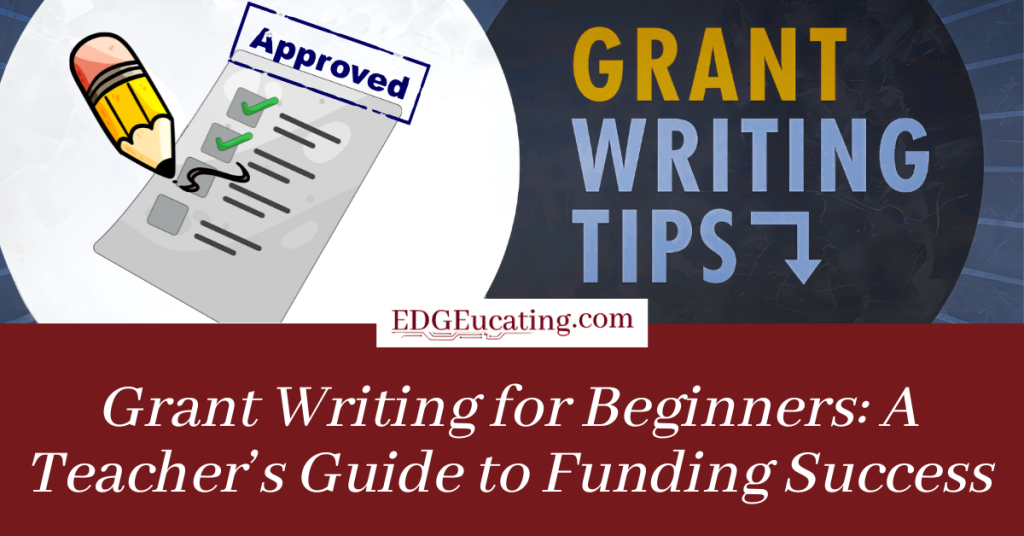The biggest hurdle in grant writing for teachers is fear—especially for beginners. I’ve been there. During my very first year in the classroom, I took a chance on writing a grant. I didn’t think I had a chance, but I figured there was no harm in trying. To my surprise, I was awarded the grant, and it changed how I thought about funding opportunities.
Over the years, I’ve written more than 14 grants, with a success rate of about 90%. They’ve ranged from local community awards for a few hundred dollars to national educational grants worth tens of thousands. That experience taught me that anyone can do this—it just takes persistence, strategy, and the right approach.
In this article, I’ll walk you through the steps I use, give examples of grant proposal examples that worked, and share strategies that can increase your chances of success.
Start Small: Take Baby Steps
Seeing what others have done can help spark your own ideas. Reviewing grant proposal examples shows you how teachers frame their needs in compelling ways.
One inspiring example comes from DonorsChoose, where teachers regularly secure funding for hands-on projects. A high school science teacher once raised over $175,000 for classroom resources by breaking the request into smaller, themed projects—lab equipment, maker kits, and even robotics tools. Each project connected directly to improving 21st century skills like problem-solving, collaboration, and creativity.
The lesson? Funders respond well to clear, specific projects with a measurable impact on students.
Be Sure the Organization Is a Fit
Not all funding opportunities are the same. If you’re applying for a technology grant, don’t ask for playground equipment. Likewise, don’t request basic laptops under a “cutting edge technology” grant. Funders want to see innovative, future-focused ideas—like project-based learning, assistive technology, or coding kits that strengthen STEM education.
The Role of Collaboration in Grant Writing
One way to stand out is by showing community partnerships in your proposal. Funders love to see collaboration because it proves your project has wide support and impact.
Consider partnering with:
- Local businesses that can provide materials or funding
- Other schools to share resources
- Community organizations (e.g., Rotary Club, Boys & Girls Clubs)
Collaboration not only strengthens your case but also aligns with funders’ priorities of equity, shared impact, and sustainability. It shows that your project will continue to thrive beyond the life of the grant.
Follow the rules!
It may sound obvious, but most proposals are rejected because applicants don’t follow instructions. If the application says “500 words or less,” don’t submit 501. Answer every question clearly and provide the exact data requested.
This attention to detail demonstrates that you’re professional, organized, and respectful of the process—qualities funders value.
Step-by-Step Grant Writing Tips
1. Know your audience
Study past recipients and learn what the funder values. Many agencies list successful applicants on their websites. If possible, ask previous winners to share their proposals with you—it’s one of the best ways to learn.
2. Keep It Simple
KISS– Keep It Simple Stupid. Avoid fluff. Reviewers are often reading dozens of proposals, so make yours easy to understand.
3. Persuade with Purpose
Show that your project is unique, achievable, and needed. Highlight how it builds real-world connections and prepares students with 21st century skills valued by both educators and employers.
4. Use Data Effectively
Don’t just state opinions—back them up. Use student performance metrics, survey results, or community impact statistics. For example, citing improvements in reading scores or STEM test results strengthens your case.
When I’ve written for STEM education initiatives, backing up my ideas with hard data about workforce needs and student engagement outcomes has always made proposals more persuasive. This gives credibility to the project that carries much more weight than what you think or believe.
5. Structure Logically
Guide reviewers from the problem to your proposed solution in a clear, step-by-step format. Make sure the project is fully explained but don’t talk over the heads of your readers. It is important to know as much as you can about your audience before you begin writing. This will ensure that you don’t insult them or confuse them.
6. Center Around a Measurable Goal
Funders want results they can measure—such as improved test scores, increased graduation rates, or higher student engagement. If your goal can’t be measured, you will not likely get funded.
7. Sell Your Story
Numbers matter, but people connect with stories. Share how funding could change a student’s learning journey. For example, describe how a robotics kit could inspire a future engineer or how assistive technology could give a struggling reader confidence. Engage their human emotions.
Before you decide on a project and the position you will take to write the proposal, remember the MOST IMPORTANT FACT –


